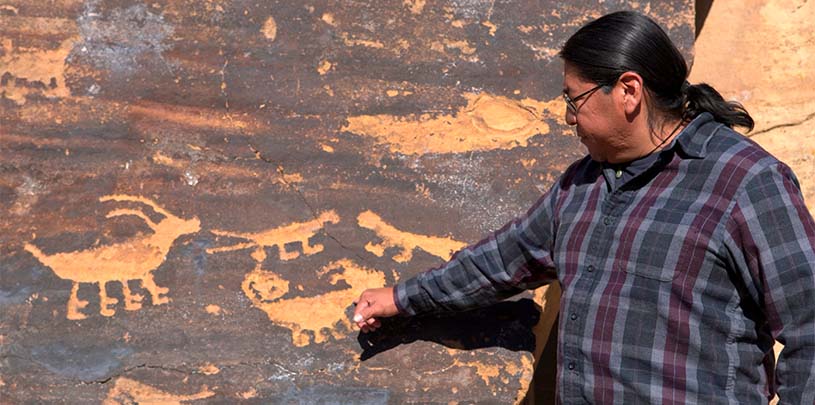
 by Sarana Riggs, Grand Canyon Manager
by Sarana Riggs, Grand Canyon Manager
For generations, Lyle Balenquah’s family has ranched in the north Oraibi Valley Wash between third and second mesa on the Hopi reservation. The ranch is a mix of old meets new. A modern plywood house sits atop a cliff band with petroglyphs etched along its base. The original ranch house from the 1800s — a masoned dwelling with roof beams from the San Francisco Peaks — still stands. Solar panels and a sun-bleached tractor hint at the climate here.
In this high elevation desert, sun is plentiful and water scarce. Even the shrubs look thirsty.
“Water is of course really important to us here in the Southwest,” Balenquah says. “I hear stories from my grandparents about how their parents would have to go down to the spring and wait in line, maybe hours, to have their chance to fill their pottery jar up. Sometimes it would be coming out drops at a time, or a little trickle.”
Hopi people depend on groundwater, and the reservation is within the watershed of the Little Colorado River. The Hopi mesas have a tilted elevation, from north to south. Winter snow and monsoon rains fall on the northern escarpment and percolate through the rock. Impermeable layers of clay force the water out horizontally, emerging at the surface as springs.
“Even though we have modern wells now and modern water infrastructure, the natural springs and watersheds still remain really important to the cultural side of Hopi people.”
Oraibi Wash is one of several major surface water drainages in Hopi. While these washes have intermittent flow and generally limited water, they are important to the environment. And they all drain south toward the Little Colorado River.
“The Little Colorado River is an important cultural landmark within Hopi history. Our ancestors were utilizing and living along the river.”
According to Balenquah, an archaeologist and outdoor guide in the Southwest, there are prehistoric settlements along the Little Colorado River that were built and occupied by Hopi ancestors over 800-1,000 years ago. You may have heard of Homolovi State Park, near Winslow, and Wupatki National Monument, near Flagstaff. Many more ancestral sites dot the banks of the Little Colorado River. He says deeper in the Little Colorado River Gorge, there are shrines, rock art, and other culturally significant areas.
The confluence, where the Little Colorado River and Colorado River meet, is especially important to Hopi people, Balenquah explains.
“Down in the confluence area, there is also the Sipapuni, which is the cultural origin point for Hopi ancestors. That emergence point symbolizes our coming from a previous world into this world seeking a new way of life,” he says. “The idea of the emergence story, I think, really is a metaphor for how we as Hopi people have developed over successive generations.”
Another important connection to the Little Colorado River, Balenquah says, is the Hopi Salt Trail.
“As part of older initiation traditions, it would have been a rite of passage for male initiates to make this long journey, a spiritually and physically dangerous journey, down into the Little Colorado River Gorge, down into the Grand Canyon, to obtain salt from the salt mines and then bring it back for their female relatives. The Salt Trail has been in existence for probably thousands of years, as long as people have been living down in the Grand Canyon.”
Balenquah also works as a Grand Canyon river guide, and while he has visited the confluence numerous times, he has never been to the physical location of the emergence point.
“That is due to cultural boundaries that I have to respect as a Hopi person. I’m not initiated into any higher religious society, and there are requirements that you have to have — spiritual preparation — in order to be involved and interact with that emergence point.”
He enjoys visiting the confluence with clients and other guides and wants them to understand the deep cultural significance of the place, to Hopi and many other tribes in the Grand Canyon region.
“Yes, it’s a beautiful area to go to when the turquoise blue waters are flowing. But I would like for them to recognize that it does still have continued cultural significance for modern day living Indigenous people.”
80% of Arizona voters support Baaj Nwaavjo I'tah Kukveni National Monument, according to a new poll.
Read MoreThe Colorado River below Glen Canyon Dam is heating up. Find out why.
Read MoreGroundwater pumping at a uranium mine near the Grand Canyon will affect the canyon's springs, scientists says.
Read More